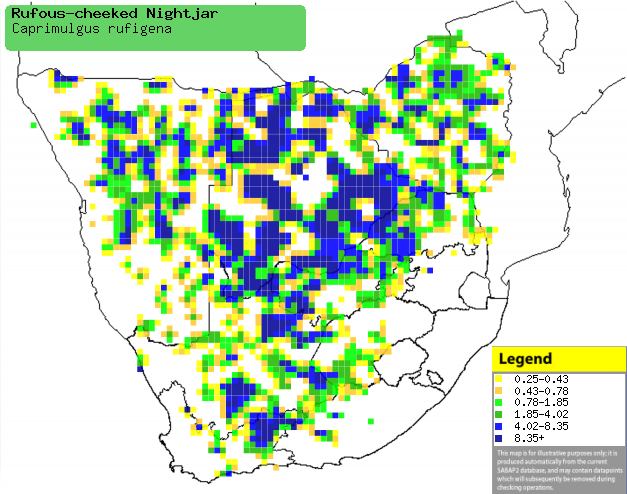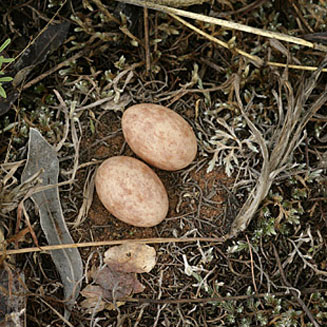|
Caprimulgus rufigena (Rufous-cheeked
nightjar)
Rooiwangnaguil [Afrikaans]; Rumbamba (generic term for
nightjar) [Kwangali]; Semanama (generic term for nightjars) [South Sotho];
Datiwa (generic name for nightjar) [Shona]; Mahulwana, Ribyatsane, Riwuvawuva
(generic terms for nighjar) [Tsonga]; Leubauba, Mmapheke, Tshogwi (all 3 are
generic terms for nightjar) [Tswana]; Roodwangnachtzwaluw [Dutch]; Engoulevent
à joues rousses [French]; Rostwangen-nachtschwalbe [German];
Noitibó-de-faces-ruivas [Portuguese]
Life
> Eukaryotes >
Opisthokonta
> Metazoa (animals) >
Bilateria >
Deuterostomia > Chordata >
Craniata > Vertebrata (vertebrates) > Gnathostomata (jawed
vertebrates) > Teleostomi (teleost fish) > Osteichthyes (bony fish) > Class:
Sarcopterygii (lobe-finned
fish) > Stegocephalia (terrestrial
vertebrates) > Tetrapoda
(four-legged vertebrates) > Reptiliomorpha > Amniota >
Reptilia (reptiles) >
Romeriida > Diapsida > Archosauromorpha > Archosauria >
Dinosauria
(dinosaurs) > Saurischia > Theropoda (bipedal predatory dinosaurs) >
Coelurosauria > Maniraptora > Aves
(birds) > Order: Strigiformes > Family: Caprimulgidae
The Rufous-cheeked nightjar is common in large parts of
southern Africa, being especially populous in Botswana and South Africa. It is
an intra-African migrant, breeding in southern Africa and moving to north at the
end of the breeding season. It lives in a variety of habitats, ranging from
Kalahari savanna to open woodland and the Karoo. It eats exclusively insects,
hunting near waterholes at dusk. It nests in natural, shallow depressions in
coarse soil, where the lay 1-2 eggs at 48h intervals, the second always being
larger and heavier than the first. It incubates them for 15-17 days, after which
the chicks hatch. They are fed and brooded by the male at dusk, freeing up the
female to feed. The stay in the nest for 15-17 days.
Distribution and habitat
Occurs from Cameroon to southern and western DRC, Angola,
Zambia and southern Africa. Within southern Africa it is common in Namibia,
Botswana (where it is the most prolific nightjar), Zimbabwe, western Mozambique, and South Africa. It
generally prefers Kalahari savanna and open woodland, especially with Mopane (Colosphermum
mopane) and Miombo (Brachystegia) trees. It's also commonly found in
kar oo
and namib semi-desert.
|
 |
|
Distribution of Rufous-cheeked nightjar in southern Africa,
based on statistical smoothing of the records from first SA Bird Atlas
Project (©
Animal Demography unit, University of
Cape Town; smoothing by Birgit Erni and Francesca Little). Colours range
from dark blue (most common) through to yellow (least common).
See here for the latest distribution
from the SABAP2. |
Movements and migrations
It is an intra-African migrant, breeding in southern Africa
from about late August to April, although it was once recorded in Zimbabwe in
mid July.
Food
Exclusively eats insects, hunting mainly at dusk, less
often on moonlit nights or dawn. It sits on the ground, usually near a
waterhole, trying to locate prey. Once it spots something, it goes on a short sortie to
grab the insect, after which it returns to the same spot. The following food
items have been recorded in its diet:
Breeding
- It nests in natural, shallow depressions in coarse soil (see image below).
 |
|
|
Rufous-cheeked nightjar clutch, Nylsvley area,
South Africa. [photo
Warwick Tarboton ©] |
|
- Egg-laying season is from September-March, peaking from
September-December.
- It lays 1-2 eggs at 48 hour intervals; the second egg is always larger
and heavier then the first. The eggs are usually light
reddish-brown with lilac markings, although they can also yellow or white.
- Incubation starts with the first egg, and lasts 15-17 days.
- The chicks are fed and brooded at dusk by the male, freeing up the
female to feed. The chicks stay in the nest for about 18-20 days.
Threats
Not threatened, in fact tolerant of areas disturbed by
humans.
References
-
Hockey PAR, Dean WRJ and Ryan PG (eds) 2005. Roberts
- Birds of southern Africa, VIIth ed. The Trustees of the John Voelcker
Bird Book Fund, Cape Town.
|
